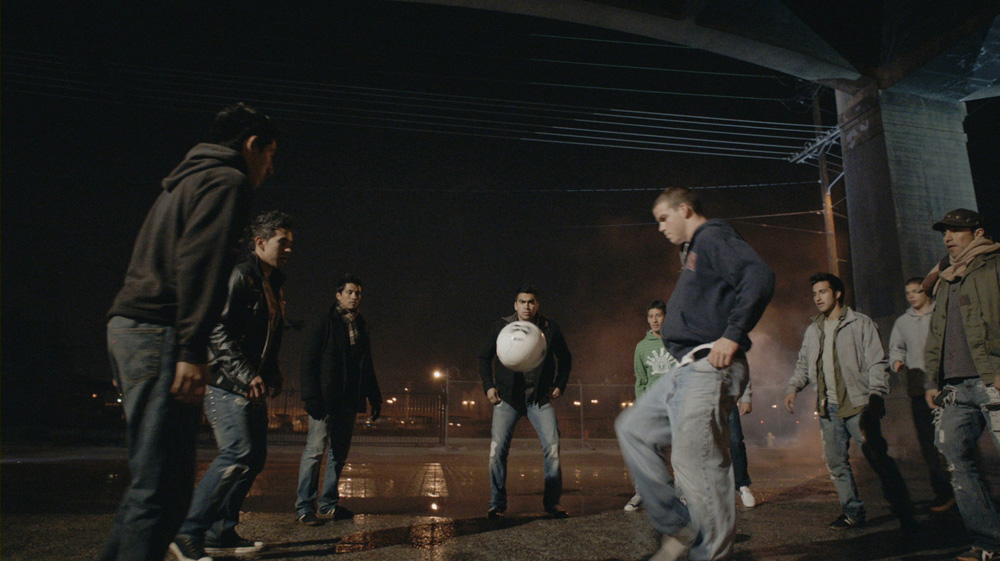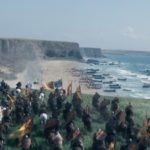
Save Big On Your Lighting Budget – Buy An Arri Alexa!
Posted on May 31, 2010 by Alex Fice
click for biggerThe cast and crew were waiting but the main star hadn’t turned up, yet. The new Arri Alexa digital camera, which Director and DoP Sam Nicholson had borrowed for his short about the World Cup. But Sam wasn’t overly concerned as his relationship with Arri and their products had flourished over thirty years of using them. He was looking forward to a camera system he could take out of the box even though it was coming directly from the airport, and make-work straightaway.
“I think we were the only people to have done a full project with it. I do a lot of camera testing, I did the first film for Sony on the F35. We get the prototypes and I generally write-up a treatment that will exercise the camera properly based on what it’s potential capabilities are. We generally start getting the first readings on these cameras about year before they come out. I did the same thing with the D20 and the D21, from a corporate standpoint they plan these products years in advance. So we get the first one and put it through it’s paces, because of that relationship over the years I have given Arri many year’s worth of input, criticism and design solutions.
“For instance I’m a great proponent of a camera that is modular which the D21 was not. So if you don’t care for instance about the eyepiece, if you don’t want a spinning mirror, a version of an electronic camera should be made without a spinning mirror. You didn’t have that choice on the D21. I felt it was extremely important to have various versions of the camera because half the weight and half the cost of building a spinning mirror camera is in the spinning mirror. A lot of cinematographers don’t really care, they don’t need a spinning mirror, some of them really need and there will be a version that has a spinning mirror that costs twice as much. But if you’ve grown up in the electronic realm then you’re comfortable with an electronic viewfinder.
 Sam Nicholson and Dana Christaansen on set for the WORLD CUP short“We highly encouraged them to have multiple models, and I think it’s a very smart move. I think they took the simplest version with the electronic viewfinder and that’s the first one out. However I think this camera is the most important one because it really sets a new benchmark for speed. I’m estimating that we can shoot not only at 800 but we can shoot at 1600, we can shoot at 3200 ISO. My next project with the camera, I’m going to do a whole short film shot at 3200 and 6400. As a very honest test, honest in quotes I guess, we didn’t want to affect this footage at all, we didn’t want to do any de-graining, we didn’t want to ‘help’ the footage out at all.
Sam Nicholson and Dana Christaansen on set for the WORLD CUP short“We highly encouraged them to have multiple models, and I think it’s a very smart move. I think they took the simplest version with the electronic viewfinder and that’s the first one out. However I think this camera is the most important one because it really sets a new benchmark for speed. I’m estimating that we can shoot not only at 800 but we can shoot at 1600, we can shoot at 3200 ISO. My next project with the camera, I’m going to do a whole short film shot at 3200 and 6400. As a very honest test, honest in quotes I guess, we didn’t want to affect this footage at all, we didn’t want to do any de-graining, we didn’t want to ‘help’ the footage out at all.
“The World Cup film has not been treated at all but if we’d used various de-graining algorithms we could take that camera up to 6400 no problem and get a beautiful image. The contrast ratio will change maybe slightly, the dynamic range will compress a little bit but it’ll be very usable for those people who want to shoot at 6400 – that’s pretty cool, that’s a definite game changer.”
Game Changing
“Lighting has always been the holy grail of cinematographers, the thing that defines a cinematographer is your ability to light. Now when you start shooting at speeds like 3200, existing lighting cinematographers are going to become a whole new category where you can go out at night and your camera actually sees more than your eye can see. It leads to a much more natural look of course and it’s a hell of a lot cheaper in terms of lighting, crew and everything else.
 All the recording options were used for this short including ProRES“We do an awful lot of television shows and we’re looking to actually cut the lighting package per show at least by a half and maybe by two thirds! That goes along with your crew – you can move much faster. If you can light with these little LED panels that are battery operated, all of a sudden you just look at cinematography a different way – you don’t look at it like ‘The big army’. All your grip starts changing, you don’t need to have a condor because you can put a light on a high ‘high stand’ and light a bridge with it. I think it’s as game changing in another arena as the Canon cameras are in terms of shooting with say a 5D or 1D Mk IV are their own realm.
All the recording options were used for this short including ProRES“We do an awful lot of television shows and we’re looking to actually cut the lighting package per show at least by a half and maybe by two thirds! That goes along with your crew – you can move much faster. If you can light with these little LED panels that are battery operated, all of a sudden you just look at cinematography a different way – you don’t look at it like ‘The big army’. All your grip starts changing, you don’t need to have a condor because you can put a light on a high ‘high stand’ and light a bridge with it. I think it’s as game changing in another arena as the Canon cameras are in terms of shooting with say a 5D or 1D Mk IV are their own realm.
“The beauty of the Arri product is that it is a very robust production machine. We’ve looked a lot at the cost of your glass on a shoot and if you’ve got a couple of $200,000 lenses are you really going to put them on a $800 Rebel DSLR? It’s like buying a Ferrari and putting regular gas in it or something, you just don’t do that.
“The camera fit perfectly in to a realm that is better than the RED, it’s got 14 stops of dynamic range and we have never seen a digital camera with 14 stops of dynamic range. Arguable the RED has ten, the Sony F35 has 12 and the Alexa has 14. We tested it very, very carefully and that can be proven.
“So its much closer to the experience of shooting on film negative and then you can derive the print that you want. So you want the maximum dynamic latitude that you can get in your digital original and then you can derive any look you want. You can get a very good look out of a RED camera but it’s always kind of crushed, the blacks in the F35 are very smooth but even smoother in the Alexa.
“I also think it’s the first digital camera to break through in terms of actresses. The reason shows like Grey’s Anatomy and Private Practice are shot on film is because of the actresses. So if you have a really smooth image as you do in film, this is the first digital camera that matches the dynamic range of film.”
SxS Recording
“We had suggested going the SxS recording route about two years ago to Arri. When the XDCAM EX came out and we were all so blown away by the SxS card, you can just pull this card and go right in to your edit system. They took it a step further with their deal with Apple I think with ProRes. At one point or another I think we put on lists everything that camera has on it, the amazing thing is that Arri really did listen to a lot of people.
 It was under the bridge that Sam realised this camera saw more in the dark than his own eyes“For instance Denny Clairmont. From his perspective he has been saying that he has to have ‘this price point’, he needs it in ‘this kind of quantity’. They always spoke of the D20 and D21 as essentially a prototype which is why to their credit they didn’t sell them. There were only leased because they knew if was a learning experience for them.
It was under the bridge that Sam realised this camera saw more in the dark than his own eyes“For instance Denny Clairmont. From his perspective he has been saying that he has to have ‘this price point’, he needs it in ‘this kind of quantity’. They always spoke of the D20 and D21 as essentially a prototype which is why to their credit they didn’t sell them. There were only leased because they knew if was a learning experience for them.
“One of the big drawbacks of the D20/21 was that it was always tethered and you were going to tape. The ProRes is the best codec out there at the moment but at the same time if you want uncompressed 4:4:4 out of the camera you can get it for green screen or if you’re going to film. You can kind of define based on what your end product is, how you configure the camera, which is the perfect thing. If you’re going out to a DI, record uncompressed HDSDI out of the two spigots at the back of the camera. But if you’re just shooting for television and you’re happy dialing in your LUT on the set then go to that ProRes because it’s beautiful. When you line the two up on monitors you really can’t tell the difference.
“One the World Cup shoot we actually mixed the recording formats. We wanted to mix using all sorts of different formats to see what we could get away with, that’s kind of what we do. One camera was shooting in Log space 4:4:4 to an STWO recorder uncompressed to see everything we could get out of the camera and then the other camera was shooting linear to ProRes 4:2:2. The two of them cut beautifully together so that says to me that particularly for television product you can define your own pipeline and I think the camera is going to have a very dramatic effect on post production.
“This is the first data centric camera that has been that friendly. I remember the RED when it first came out, it had real problems with the workflow which have largely been solved but much of the initial reputation of that camera was that it had a difficult workflow. It didn’t fit with the big production pipelines of television. It’s great for independent users but these pipelines are built on SR tape and telecine and the QC’ing that goes on. For the first year or two it was a very rough road in the post pipeline for RED. But clearly the ProRes 4:4:4 pipeline with both Final Cut and now with Avid adopting is going to become an industry standard I think for television work.
“I think the Alexa is going to hit hardest in television production initially but also it will hit very dramatically in to features because the full chip version of the camera which is coming out later this year will shoot anamorphic. Once you get that full chip that’s a big deal with anamorphic, there is no other camera that will do that. We use the HD SDI output of the camera a lot in real time compositing so we need the real time HD SDI out, but it’s also one of the drawbacks that we’ve had with the RED that it doesn’t output 1920×1080 live.”
Why Alexa?
“There are lots of reasons we find Alexa helpful to us. You can record multiple resolutions at the same time and rather than the live being a step down, like a proxy as it is in the RED, it’s actually higher quality. Sounds like a small difference but it’s a major difference for us doing visual effects.
“The response from the market has been incredible. To introduce a new digital camera at this point and have literally thousands of people lining up is pretty incredible. In many ways this is kind of the perfect camera. It’s a real production camera that’s tested extensively by Arri. Every camera that comes off their assembly line is going to be ready to put in to production right out of the box.
“That’s what you need. Denny Clairmont will attest to the fact that when he first got the Sony cameras he had to re-build all the fronts because the lens mounts were not accurate enough. The initial lens mounts on the RED cameras were completely off, it was an aluminium lens mount which was completely unacceptable. If every camera focuses differently it’s a little frustrating!
“Also Arri cameras of old haven’t always had an intuitive menuing system. You would have three buttons on the side of the camera that would do everything. It was like opening a safe or something. So we’d take Palm Pilots or whatever and write code that would bypass the software and get to it with a button push. This camera has all these neat little glowing buttons which you can find in the dark and do just about anything you need to do within one or two button pushes.
“Alexa is just the right level of complexity and it’s the menu system that makes it a very friendly and very easily understood camera. We had never worked with camera before and nobody on the crew had ever seen the camera before and we started shooting without missing a beat.
“Maybe this camera will affect a huge shift in the industry, moving away from tape and going data centric. It’s going to change a ton of stuff. The fact that you can record a high res master 4:4:4 log, whatever, and you can be recording a simultaneous ProRes 4:4:4 for your editors so that they can begin editing immediately is awesome. That really is a revolutionary camera that not only changes the way we shoot and what we shoot and how we shoot it but how the projects are finished.
“It’s clearly going to affect dailies. Once the workflow is clearly established it may take your whole dailies equation and change it where you aren’t going to timing every day. That’s worth about $1500 a day to be able to skip over a few steps in post. Which is more than enough to afford the camera.
People handle tape much like they handled film, the post production pipeline didn’t change that radically. Your tape masters went off to be timed, selected and takes pulled which is pretty close to working in film really. This camera changes that.








